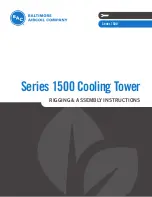
3
Do not remove the cabinet knockouts until it has been
determined which knockouts will need to be removed for the
installation.
Select the final installation position which best suits the site
conditions. Consider required clearances, space, routing
requirements for refrigerant line, condensate disposal, filters,
ductwork, wiring, and accessibility for service. Refer to the air
handler rating plate on the air handler for specific information.
Tools and Parts
Gather the required tools and parts before starting installation.
Read and follow the instructions provided with any tools listed
here.
Tools Needed
Parts Needed
Check local codes, check existing electrical supply, and read
“Ductwork Requirements” and “Electrical Requirements” before
purchasing parts.
System Requirements
The air handler is designed to match, and must be used with
outdoor units as rated. The indoor units are manufactured with an
interchangeable refrigerant metering orifice to provide optimum
refrigerant control and system performance with a variety of
different capacities of outdoor units.
In some cases, the rating of the outdoor unit may require that the
air handler coil assembly orifice be changed to obtain rated
performance.
Location Requirements
NOTE: When used on cooling applications, excessive sweating
may occur when the air handler is installed in a very humid
space.
■
If the air handler is installed in an unconditioned space,
sealant should be applied around the electrical wires,
refrigerant tubing, and condensate lines where they enter the
cabinet.
■
Electrical wires should be sealed on the inside where they exit
the conduit opening. Sealant is required to avoid air leakage
and condensate from forming inside the air handler, control
box, and on the electrical controls.
■
The air handler must be installed in such a way as to allow
free access to the coil/filter compartment and blower/control
compartment.
■
The air handler must be installed in a level position to ensure
proper condensate drainage.
Installation Clearances
Non-Duct Return Closet Installation
The air handler can be installed in a closet with a false bottom to
form a return air plenum or be installed with a return air plenum
under the air handler.
Louvers or return air grilles are field supplied. Local codes may
limit the application of systems without a duct return to single-
story buildings.
■
For an air handler installed in a closet with a louvered return
opening, the minimum open area for the louvers will be as
shown below.
■
If the free area is not known, assume a 25% free area for
wood louvers or a 75% free area for metal louvers or grilles.
■
Using the louver dimensions and the 25% or 75%
assumption, determine if the louver open area meets the
minimum open area listed in the previous chart.
■
If the return air plenum is used, the return air grille should be
immediately in front of the opening in the plenum to allow for
the free flow of return air.
■
When the air handler is not installed in front of the opening,
there must be adequate clearance around the air handler to
allow for the free flow of return air.
■
The unit clearance from a combustible surface may be 0".
■
Allow a minimum of 24" (61 cm) in front of the unit for service
clearance.
■
Do not install the air handler in a location that violates the
instructions provided with the condenser.
■
If the unit is located in an area with high ambient temperature
and/or high humidity, the air handler may have condensation
on the casing. On these installations, a wrap of 2" (5.1 cm)
fiberglass insulation with a vapor barrier is recommended.
■
Consult all appropriate regulatory codes prior to determining
final clearances.
■
When installing this unit in an area that may become wet,
elevate the unit with a sturdy, non-porous material.
■
In installations that may lead to physical damage (for
example. in a garage) it is recommended that a barrier be
installed to avoid such damage.
■
¹⁄₄
" nut driver
■
Level
■
Screwdriver
■
Adjustable wrench
■
Tape measure
■
Hammer
■
Sealant
■
UL-Listed wire connectors
■
Replacement orifice (if needed). See “Verify Orifice Size.” The
correct orifice size may be contained in the replacement
orifice package located inside the control box of the outdoor
unit. If this package does not contain the correct orifice for
your air handler, you must purchase the correct orifice size.
18" and 24" (45.7 cm and
61 cm) models
320 sq. in. (2,065 cm
2
)
30" and 36" (76.2 cm and
91.4 cm) models
360 sq. in. (2,323 cm
2
)
42", 48" and 60" (106.7 cm,
121.9 cm and 152.4 cm) models
450 sq. in. (2,903 cm
2
)




































